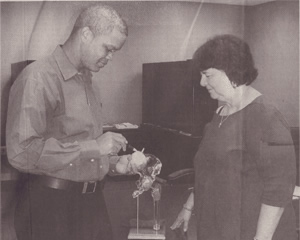Surgery Saves Bone Mass
Special Procedure Reduces Follow-Ups
By Sonya Elkins
Rome News-Tribune Staff Writer
SElkins@TN-T.com | (706) 290-5278
 When Marilyn Johnson of El Paso, Texas, Met orthopaedic Surgeon Dr. Kenneth Sands she was looking for a house, not a doctor.
When Marilyn Johnson of El Paso, Texas, Met orthopaedic Surgeon Dr. Kenneth Sands she was looking for a house, not a doctor.
The new Harbin Clinic surgeon performed the first Birmingham Hip Resurfacing procedure done in the state of Georgia on Johnson this August. Johnson followed Sands to Rome to have the alternative to total hip replacement all the way from Texas.
However, it wasn’t a doctor’s office where Johnson initially met her surgeon. She and her husband were buying Sands’ home which he was selling in preparation to make his move to Rome.
“I was drawn to him,” Johnson said. “You don’t see many doctors that are that excited about what they’re doing. He’s very passionate.”
And as luck would have it, Johnson at age 53 was an ideal candidate for the procedure, Sands said Good candidates for the procedure are active patients younger than 60.
The BHR procedure was initially pioneered by British orthopaedic surgeons and was in wide international usage by 1997. In May 2006, the FDA approved the procedure in the United States. Because of a request of the FDA for continued training, Sands is currently one of only 50 surgeons who were selected throughout the United States to perform the surgery in the country.
“The advantage for younger patients is it will allow them to be more active and preserves their bone stock,” Sands said.
More than 300,000 hip replacements are performed yearly in the United States with a 95 percent to 99 percent 10 year success rate. However, that drops when studies look at active patients younger than 55 where bone loss is a significant complication.
The BHR is a ball and socket joint allowing more femoral bone to be preserved during surgery. In a total hip replacement, the entire femoral head and neck must be removed, however the BHR leaves these untouched.
Because a BHR procedure generally causes less loss of bone density over time, revision surgeries – which may be required after a certain length of time after either BHR or traditional hip surgeries – will likely be less complicated. The implant is a metal-on-metal ball and socket reducing wear that frequently leads to follow-up surgeries for patients that receive traditional metal-on-plastic ball and socket implants.
Another advantage of the procedures is decreased chance of dislocation caused by the increased size of the femoral head over that used in a traditional hip implant, Sands said.
One of the advantages that attracted Johnson to the surgery was the reduced recovery time because of the less invasive nature of the procedure, which as been about half the time of traditional hip replacements in European studies, she said.
Johnson has been dealing with a lot of pain caused by her condition for three years now. That pain affects everything she did in her daily life, she said. She hates missing out on everyday parts of her active life such as getting down on the floor wither her grandson or walking her dogs.
“My goal is just to resume my normal life, which has been so affected by the hip pain,” she said. “It isn’t just my hip – it affects my leg, my knee, my ankle. It really affects your entire way of life. I feel likes a really old lady but mentally I'm in my 20s.”
Sands successfully performed Johnson's surgery Aug. 15. She stayed in town for follow-up visits for two weeks following her procedure.
Almost two weeks after her surgery, Johnson was already excited about her results. She said she felt almost pain-free and had already ditched the walker she needed right after the surgery for a cane, which she expected to no longer need by the end of her two weeks. She had already gone to the mall movies and dinner every night, she said.
“After going through this and seeing the shorter recovery time, this is definitely the way to go,” she said. “I came into this kind of blindly and I couldn't be happier.”
Sands expects for the new procedure to make up about 20 percent of his practice in Rome.
Last Modified: November 5, 2020